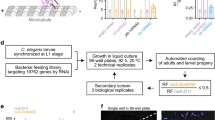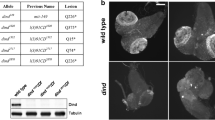Abstract
In fission yeast the Weel kinase and the functionally redundant Mikl kinase provide a regulatory mechanism to ensure that mitosis is initiated only after the completion of DNA synthesis. Yeast in which both Weel and Mik1 kinases are defective exhibit a mitotic catastrophe phenotype, presumably due to premature entry into mitosis. Because of the functional conservation of cell cycle control elements, the expression of a vertebrate weel or mikl homolog would be expected to rescue such lethal mutations in yeast. A Xenopus total ovary cDNA library was constructed in a fission yeast expression vector and used to transform a yeast temperature-dependent mitotic catastrophe mutant defective in both weel and mikl. Here we report the identification of a Xenopus cDNA clone that can rescue several different yeast mitotic catastrophe mutants defective in Weel kinase function. The expression of this clone in a weel/mikl-deficient mutant causes an elongated cell phenotype under non-permissive growth conditions. The 2.0 kb cDNA clone contains an open reading frame of 1263 nucleotides, encoding a predicted 47 kDa protein. Bacterially expressed recombinant protein was used to raise a polyclonal antibody, which specifically recognizes a 47 kDa protein from Xenopus oocyte nuclei, suggesting the gene encodes a nuclear protein in Xenopus. The ability of this cDNA to complement mitotic catastrophe mutations is independent of Weel kinase activity.
Similar content being viewed by others
References
Addison C, Jenkins J, Sturzbecher HW (1990) The p53 nuclear localization signal is structurally linked to a p34cdc2 kinase motif. Oncogene 5:423–426
Amon A, Surana U, Muroff I, Nasmyth K (1992) Regulation of p34cdc28 tyrosine phosphorylation is not required for entry into mitosis in S. cerevisiae. Nature 355: 368–371
Booher R, Beach D (1986) Site-specific mutagenesis of cdc2 +, a cell cycle control gene of the fission yeast Schizosaccharomyces pombe. Mol Cell Biol 6:3523–3530
Booher RN, Alfa CE, Hyams JS, Beach DH (1989) The fission yeast cdc2/cdc13/sucl protein kinase: regulation of catalytic activity and nuclear localization. Cell 58:485–497
Booher RN, Deshaies RJ, Kirschner MW (1993) Properties of Saccharomyces cerevisiae weel and its differential regulation of p34CDC28 in response to G1 and G2 cyclins EMBO J 12:3417–3426
Brizuela L, Draetta G, Beach D (1987) p13suc1 acts in the fission yeast cell division cycle as a component of the p34cdc2 protein kinase. EMBO J 6:3507–3514
Dingwall C, Laskey RA (1991) Nuclear targeting sequences—a consensus? Trends Biochem Sci 16:478–481
Ducommun B, Brambilla P, Felix MA, Franza BR, Karsenti E, Draetta G (1991) cdc2 phosphorylation is required for its interaction with cyclin. EMBO J 11: 3311–3319
Dunphy WG, Brizuela L, Beach D, Newport J (1988) The Xenopus cdc2 protein is a component of MPF, a cytoplasmic regulator of mitosis. Cell 54:423–431
El-Deiry WS, Tokino T, Velculescu VE, Levy DB, Parsons R, Trent JM, Lin D, Mercer WE, Kinzler KW, Vogelstein B (1993) WAFT, a potential mediator of p53 tumor suppression. Cell 75: 817–825
Enoch T, Nurse P (1991) Coupling M phase and S phase: controls maintaining the dependence of mitosis on chromosome replication. Cell 65:921–923
Featherstone C, Russell P (1991) Fission yeast p107wee1 mitotic inhibitor is a tyrosine/scrine kinase. Nature 349: 808–811
Gabrielli BG, Roy LM, Gautier J, Philippe M, Matter JL (1992) A cdc2-related kinase oscillates in the cell cycle independently of G2/M cyclins and cdc2. J Biol Chem 267:1969–1975
Gautier J, Norbury C, Lohka M, Nurse P, Matter J (1988) Purified maturation-promoting factor contains the product of a Xenopus homolog of the fission yeast cell cycle control gene cdc2+. Cell 54:433–439
Gautier J, Solomon MJ, Booher RN, Bazan JF, Kirschner MW (1991) cdc25 is a specific tyrosine phosphotase that directly activates p34cdc2. Cell 67:197–211
Gould KL, Nurse P (1989) Tyrosine phosphorylation of the fission yeast cdc2 + protein kinase regulates entry into mitosis. Nature 342:39–45
Gould KL, Moreno S, Owen DJ, Sazer S, Nurse P (1991) Phosphorylation at Thr167 is required for fission yeast p 34cdc2 function. EMBO J 10:3297–3309
Gu Y, Turck CW, Morgan DO (1993) Inhibition of CDK2 activity in vivo by an associated 20k regulatory subunit. Nature 366:707–710
Hagan IM, Hayles J, Nurse P (1988) Cloning and sequencing of the cyclin-related cdc13 + gene and a cytological study of its role in fission yeast mitosis. J Cell Sci 91: 587–595
Harlow E, Lane D (1988) Antibodies: a laboratory manual. Cold Spring Harbor Laboratory Press, Cold Spring Harbor, New York
Igarashi M, Nagata A, Jinno S, Suto K, Okayama H (1991) Wee1+-like gene in human cells. Nature 353: 80–83
Kemp BE, Pearson RB (1990) Protein kinase recognition sequence motifs. Trends Biochem Sci 15:342–346
Kumagai A, Dunphy WG (1991) The cdc25 protein controls tyrosine dephosphorylation of the cdc2 protein in a cell-free system. Cell 64:903–914
Lee MS, Ogg S, Xu M, Parker LL, Donoghue DL, Maller JL, Piwnica-Worms H (1992) cdc25 + encodes a protein phosphatase that dephosphorylates p34cdc. Mol Biol Cell 3:73–84
Lohka MJ, Hayes MK, Matter JL (1988) Purification of maturation-promoting factor, an intracellular regulator of early mitotic events. Proc Natl Acad Sci USA 85:3009–3013
Lundgren K, Walworth N, Booher R, Dembski M, Kirschner M, Beach D (1991) mikl and weel cooperate in the inhibitory tyrosine phosphorylation of cdc2. Cell 64:1111–1122
Matter JL (1994) Biochemistry of cell cycle checkpoints at the G2/M and metaphase/anaphase transitions. Semin Dev Biol 5: 3061–3068
Maundrell K (1993) Thiamine-repressible expression vectors pREP and pRIP for fission yeast. Gene 123:127–130
McLeod M, Stein M, Beach D (1987) The product of the mei3 + gene, expressed under control of the mating-type locus, induces meiosis and sporulation in fission yeast. EMBO J 6:729–736
Millar JBA, McGowan CH, Lenaers G, Jones R, Russell P (1991) p80cdc25 mitotic inducer is the tyrosine phosphatase that activates p34cdc2 kinase in fission yeast. EMBO J 10:4301–4309
Molz L, Beach D (1993) Characterization of the fission yeast mcs2 cyclin and its associated protein kinase activity. EMBO J 12:1723–1732
Molz L, Booher R, Young P, Beach D (1989) cdc2 and the regulation of mitosis: six interacting mcs genes: Genetics 122:773–782
Moreno S, Hayles J, Nurse P (1989) Regulation of p34cdc2 protein kinase during mitosis. Cell 58: 361–372
Moreno S, Nurse P, Russell P (1990) Regulation of mitosis by cyclic accumulation of p80cdc25 mitotic inducer in fission yeast. Nature 344:549–552
Moreno S, Klar A, Nurse P (1991) Molecular genetic analysis of fission yeast, Schizosaccharomyces pombe. Methods Enzymol 194:795–823
Murray A (1989) The cell cycle as a cdc2 cycle. Nature 342:14–15
Murray A (1992) Creative blocks: cell-cycle checkpoints and feedback control. Nature 359: 599–604
Murray A, Hunt T (1993) The cell cycle: an introduction. W.H. Freeman and Company, New York.
Nurse P (1975) Genetic control of cell size at cell division in yeast. Nature 256:547–551
Nurse P (1990) Universal control mechanism regulating onset of M-phase. Nature 344:503–507
Parker LL, Atherton-Fessler S, Piwnica-Worms H (1992) p107wee1 is a dual-specificity kinase that phosphorylates p34cdc2 on tyrosine 15. Proc Natl Acad Sci USA 89:2917–2921
Pines J, Hunter T (1990) p34cdc2: the S and M kinase. New Biol 2:389–401
Robbins J, Dilworth SM, Laskey RA, Dingwall C (1991) Two interdependent basic domains in nucleoplasmin nuclear targeting sequence: identification of a class of bipartite nuclear targeting sequence. Cell 64:615–623
Russell P (1983) Evolutionary divergence of the mRNA transcription initiation mechanism in yeast. Nature 301:167–169
Russell P, Hall BD (1983) The primary structure of the alcohol dehydrogenase gene from the fission yeast Schizosaccharomyces pombe. J Biol Chem 258:143–149
Russell P, Nurse P (1986) cdc25 + functions as a mitotic inducer in fission yeast. Cell 45:145–153
Russell P, Nurse P (1987) Negative regulation of mitosis by weel +, a gene encoding a protein kinase homolog. Cell 49:559–567
Sambrook J, Fritsch EF, Maniatis T (1989) Molecular cloning: a laboratory manual. Cold Spring Harbor Laboratory Press, Cold Spring Harbor, New York
Serrano M, Hannon GJ, Beach D (1993) A new regulatory motif in cell-cycle control causing specific inhibition of cyclin D/CDK4. Nature 366:704–707
Simanis V, Nurse P (1986) The cell cycle control gene cdc2 + of fission yeast encodes a protein kinase potentially regulated by phosphorylation. Cell 45:261–268
Sorger PK, Murray AW (1992) S-phase feedback control in budding yeast independent of tyrosine phosphorylation of p34cdc28. Nature 355:365–368
Strausfeld U, Labbe JC, Fesquet D, Cavadore JC, Picard A, Sadhu K, Russell P, Doree M (1991) Dephosphorylation and activation of a p34cdc2/cyclin B complex in vitro by human CDC25 protein. Nature 351:242–245
Su JY, Maller JL (1994) Identification of a Xenopus cDNA that prevents mitotic catastrophe in the fission yeast Schizosaccharomyces pombe. Gene 145:155–156
Xiong Y, Hannon GJ, Zhang H, Casso D, Kobayashi R, Beach D (1993) p21 is a universal inhibitor of cyclin kinases. Nature 366:701–704
Author information
Authors and Affiliations
Additional information
Communicated by B. Kilbey
Rights and permissions
About this article
Cite this article
Su, JY., Maller, J.L. Cloning and expression of a Xenopus gene that prevents mitotic catastrophe in fission yeast. Molec. Gen. Genet. 246, 387–396 (1995). https://doi.org/10.1007/BF00288613
Received:
Accepted:
Issue Date:
DOI: https://doi.org/10.1007/BF00288613




